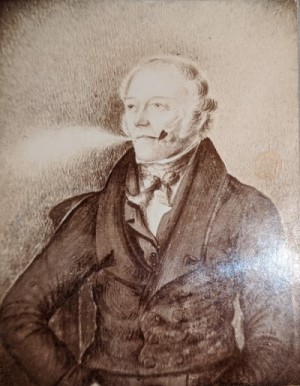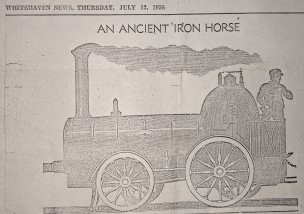
See also the main Swainson line page and research notes.

I know little of Taylor's early to middle years. His baptism on 4 October 1761 at St Nicholas, Whitehaven appears in the IGI. His parents were John and Ann SWAINSON. I'm confident this is him because there are few Taylor SWAINSONs in the IGI and this is the earliest; the date and place fit with other evidence about his life; and the parents' names fit with a SWAINSON-TAYLOR marriage in the same town shortly before.
He must have had some schooling, so try looking for records of that. Also any early employment.
In 1789 he witnessed the marriage of his sister Ann to Thomas SMITH.
I have no further record of him until the 1802 payroll of Howgill Colliery, posted public-spiritedly by Roland Grigg on his website, which lists him as an engineman and gives his age as 40 - linking that birth with all the colliery and engineering evidence.
(some background required on Howgill Colliery and the Whitehaven collieries in general)
My source for most of the information about Taylor's own family is Alison France and Lynne Hall (current web page). They have gone through the registers for the various parishes of Whitehaven and some other records, and recorded what they have found relating to the SWAINSON name. They've shared their data with me and I can support these conclusions. Taylor married Eleanor SMITH (the sister of Taylor's brother-in-law Thomas SMITH)in 1805 at St Nicholas Church, Whitehaven.
Taylor and Eleanor had seven children:
Eleanor 1806
John Bateman 1808
Ann 1811
Thomas 1813
Margaret 1816
Taylor 1818
William 1821 and probably buried 1823
Some addresses are given for the family in these event records: Peter Street in 1806; Newtown 1816-21. But William is described as 'Poor House' when buried aged 2 in 1823; I'm not sure whether the omission of his parents suggests that they were not inmates, or whether it is just a matter of the recording convention or the secondary compilation of events I've got it from.
This was summed up rather neatly for me by one of my first contacts in famiy history, Sheila Lawson of the Cumbria FHS, who said he was 'a brilliant engineer but also a drunkard, who died in the workhouse'.
While starting his family, Taylor rose to be the leading engineer of the colliery. He became a legend locally as a steam engine inventor (the obituary of his son Taylor SWAINSON, in the Whitehaven Gazette of 25 February 1897, mentions Taylor senior as "said to have been the real inventor of the locomotive", and I'm told that a local museum also reports some such claim). However, the truth seems to be a bit more limited. 'A History of Railway Locomotives Down to the End of the Year 1831' by C. F. Dendy Marshall (published in 1953 by the Locomotive Publishing Company Ltd, London, and now available on Google Books) has 20 chapters devoted to railway locomotive pioneers, in broadly chronological order. Richard Trevithick is first, Taylor Swainson third and George Stephenson eighth.
Taylor Swainson ran an engine called the Iron Horse on rails at the Whitehaven collieries in 1812 (from Wellington Pit to the harbour, according to a family account), but the rails were not strong enough and the arrangement was not a success. The engine was probably made at Whitehaven by Swainson, rather than being bought in or constructed by anyone else, but a drawing of the engine suggests that it followed closely Richard Trevithick's design, first built 8 or 10 years before. George Stephenson built his first locomotive in 1814 and there were others operating around the country at about these dates, built by several engineers more or less following Trevithick. However, Stephenson is often wrongly thought of as inventing the steam locomotive, because he built a famous one (the Rocket) and did much to pioneer public commercial railways. So, since Swainson was earlier, the confusion is perhaps understandable.

Marshall has a note that Swainson may have seen a Trevithick engine in Wales, since he had family connections there. I don't have any Wales connection for the SWAINSONs this far back, though I do in later generations. Worth bearing this in mind.
A website about railway history mentions him, unfortunately without unambiguously specifying the source, as putting together an engine in 1817. The source may have been the Haig Pit website but that is currently (March 2010) under renovation. Also, it seems from Google that there's a reference to him in the book A Cumberland Colliery during the Napoleonic War, by Oliver Wood © 1954 The London School of Economics and Political Science. It is on JSTOR here but I don't have access to more than the first page. I can't tell from the Google clip that it adds anything. There's also apparently a reference to him in the Rees paper listed here but I don't think it is sure to add anything to Marshall.
I don't have any later career references than 1817 but it may well be that he retired in his 50s or 60s - or became unable to work...
It seems that Taylor abused alcohol from at least 1803, two years before his marriage to Eleanor. He suffered from debilitating lapses that kept him from his work for periods of time.
The following passage is from a letter from John Bateman, an agent of Lord Lonsdale the colliery owner, to his employer, dated 24 January 1803.
"Poor Taylor Swainson has quite fallen away to hard drinking and his fine abilities seem much hurt with it. About a fortnight before we got Wilson Pit machine finished he broke out. I got him checked several times since by getting our people to keep is money to prevent him buying liquors, got him sober and to work again with strong promises of amendment. His mother is worse than himself. She has pawned and sold nearly all that they have, even their wearing apparel but what is worse than all, I am told she has stolen their grate bars under their kitchen water grate and sold them for drink. His friends want her sent from Saltom. They say that while she is there he will never mend. They want him to put some decent family into the house and lodge with them. I am quite at a loss as to what to do as she is taken to stealing she may carry off fronts a very amount. I am told the cloth we gave him the other day of a suit of clothes is either sold or pawned tho' he has not clothes suffiicient tokeep him warm. What a pity such fine abilities should be so ill employed."
The Marshall book mentioned above quotes an extract from a diary of a Whitehaven printer by the marvellous name of Noble STEELE, relating an anecdote from his childhood in 1812. After that date the diarist was at school with one of Taylor's sons. I originally quoted on this page a rather sanitised version of the story, but I have now found a version that rings truer and refers directly to the impact of alcohol on Taylor's work, supporting the earlier letter quoted above:
"Swainson was a dissipated, but very clever man, and I was truly sorry to hear that he had been allowed to end his says in the workhouse. As some proof that Swainson was the inventor of the 'iron horse', I may here mention that when the machine was nearly completed he indulged in one of his terrible "sprees" and when in this state nothing would unduce him even to attempt working. [the Earl of Lonsdale's colliery agent wanted to see the Iron Horse at work... an expert engineer sent for from Newcastle was unable to get it going...] and there the ingenious contrivance stood still awaiting the return to usefulness and activity of poor Swainson. At length the inventor was himself again and the Iron Horse was in less than a week set in motion, to the wonder and admiration of congregated thousands."
Another descendant, Carla Fisher, had a family story passed down from her great-grandfather Thomas Taylor SWAINSON, himself the great-grandson of the original Taylor, that Taylor would regularly drink with George STEPHENSON (presumably the locomotive engineer) at the White Bull pub in Whitehaven, sited where the Civic Centre now is, and that it would be these sessions that would leave him incapable of work. And that nobody else could opreate the Iron Horse and that the pit, being reliant on its traction, would then grind to a halt.
We can only speculate whether he might have been more successful and as an engineer if he had been sober.
I don't currently have any record of him after 1818, until he was buried in 1839, having died in Scotch Stret workhouse at Whitehaven.
According to his obituary, he was a “highly talented engineer and draughtsman in the employ of the Earl of Lonsdale” - I have this again from the Swainson web page so I need to track down that obituary.
If you are interested in this line I'll be very pleased indeed to hear from you. Email me at deletethis.ianwilliamson161@gmail.com though obviously you edit the email address before you send. Remove everything up to and including the first dot, leaving just my initial, surname and number before the @. Please do not delete the automatically-generated subject line, so that I know your email is not spam. You can add more to the subject if you like but if you delete what appears I may not read your mail.